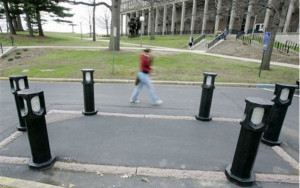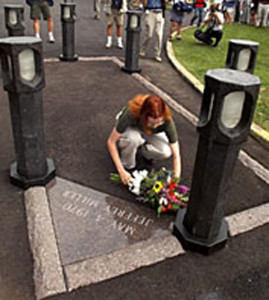Last year at this time, I was composing Jonestown Triptych for snare drum and computer, which relies heavily on excerpts of the audio samples available through the Jonestown Institute.
The piece premiered in April 2010 at the University of Akron. Scott Farkas (who commissioned the piece) played it very well, and the technology generally behaved itself. The next step is to find the time and resources to make a professional recording of the piece for release. Recording a piece that uses acoustic instruments and interactive electronics can be tricky, but with the right engineer, Scott and I should be able to do it. Any percussionists reading this who would like to obtain the performance materials can write to me at billsallak@gmail.com.
I realized as I have written about my work that there is an unsettling tone of emotional detachment that pervades it. On the one hand, it’s not surprising: the Jonestown audio samples were never central to the initial project – I discovered them while scouring the Internet for interesting audio – and even if they were, it’s almost impossible for an artist to work with them meaningfully by emotionally amplifying them. While Theodor Adorno may not have been entirely accurate when he proclaimed that writing poetry after Auschwitz was barbaric, he hit on a very important idea: making art from the raw material of human tragedy is fraught with opportunities for emotional manipulation and inauthenticity. Artists often have a tendency to find materials to which they can “do something,” and Jonestown does not need to be manipulated to be effective: while it may not say precisely the same thing to each person, it does speak for itself.
On the other hand, might it not be disingenuous of the artist to believe that he or she can handle emotionally-charged materials in a sanitized or prophylactic manner? Isn’t it unavoidable to be affected somehow? I suspect that the answer to both propositions is yes, though I’m still not quite able to find meaningful words to describe exactly how.
I teach at a university that has also known its own small share of needless killing.
This past spring, Kent State marked the 40th anniversary of the events of May 4, 1970. The places where each student fell are marked by rectangular panels set in the ground (the area is now mostly occupied by a parking lot) and surrounded with short columns topped with lights. These memorial markers are extremely effective, in large part because they do not attempt to “do something” with their subject. Instead, they demarcate a space, focus the attention, and distill meaning into a small area that is all the more striking because of its physical emptiness. When mourners placed flowers at the markers last May, it was perhaps the first time I saw people touching the lit columns and stepping into the rectangular spaces they defined.
It wasn’t until after seeing the way that those memorials functioned that I could begin to see the ways in which Jonestown Triptych is an attempt to demarcate a span of time, focus one’s attention, and distill meaning by making the artist’s presence as transparent as possible, letting the voices speak for themselves. And it’s by hearing and thinking on these voices that we can continue to show that Adorno is wrong, and keep barbarism confined to the past.
(Bill Sallak is Assistant Professor/Dance Music Director at the School of Theatre and Dance at Kent State University in Kent, Ohio.)

